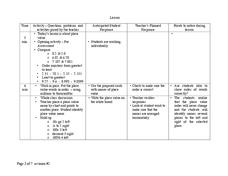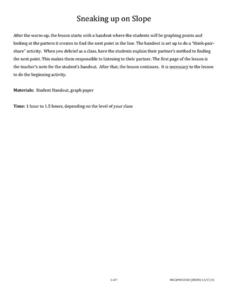Willow Tree
Linear Relationships
There's just something special about lines in algebra. Introduce your classes to linear equations by analyzing the linear relationship. Young mathematicians use input/output pairs to determine the slope and the slope-intercept formula to...
Theodore Roosevelt Association
Theodore Roosevelt: A Presidential Timeline
Throughout his life and presidency, Theodore Roosevelt contributed to the America we know today in so many ways. An adaptable lesson plan prompts young historians to create a chronological timeline of Roosevelt's contributions to...
Computer Science Unplugged
Twenty Guesses—Information Theory
How do we determine how much information to include and what can be left out? By playing a game of 20 questions, the class generates the best strategies for finding a number. They then move on to guessing the next letter in a short...
Curated OER
There's Gold in Them Thar Ratios
Students draw a model of the bunny problem which generates the Fibonacci Sequence, spirals generated from golden rectangles and golden triangles; identify the golden ratio in the human body, and find the Fibonacci numbers in nature.
Curated OER
The Billy Goats Gruff and the Days of the Week
First graders explore the days of the week. In this days of the week instructional activity, 1st graders listen to the story The Billy Goats Gruff, then act out the events by stepping on "rocks" that name the days of the week. Students...
Curated OER
Tumbling and Movement
Students perform basic tumbling activities. For this movement lesson, students practice tumbling and balancing moves while listening to music. Students are "frozen" into place while in certain positions.
Curated OER
Finding the Shortest Total Distance possible
In this geometry worksheet, students solve the problem of finding the shortest total distance traveling in straight lines. The solution is provided.
Curated OER
Where Math Meets Poetry
Students identify Fibonacci's sequence of numbers and use the pattern to write poetry with one syllable words. In this math and writing lesson, students identify Fibonacci's sequence of numbers and learn about this early mathematician....
Curated OER
Inductive Reasoning
In this algebra worksheet, 10th graders apply inductive reasoning as they figure out the next number in the sequence or pattern. There are 53 problems.
Curated OER
Place Value
Practice place value skills with this lesson. Learners put numbers in order from greatest to least, identify the values of particular numbers, and engage in an activity to compare numbers using manipulatives.
Curated OER
The Clumsy Tiler N (Fractions)
Students explore patterns and geometric sequencing. Students devise and use problem solving strategies to explore situations mathematically. Students solve real life problems. They demonstrate, with cardboard pieces, fraction and...
Curated OER
The Clumsy Tiler N (Metric)
Students explore patterns and geometric sequencing. Students devise and use problem solving strategies to explore situations mathematically. Students solve real life problems. They demonstrate, with cardboard pieces, fraction and...
Curated OER
Mixed Fraction Sequences
In this math learning exercise, students complete the mixed fractions that are sorted into a sequence. The sheet is intended as a teacher's guide.
Curated OER
Decimal Sequences
In this math worksheet, students solve the problems that are intended to focus upon he sequences of decimals. The sheet is a teacher's guide.
Curated OER
Stoplight Problem Solving
In this problem solving worksheet, students use the six different columns to create six different patterns for the red, yellow, and green lights for a stop light.
Curated OER
No-Three-In-A-Line Again
Students interpret information and results in context while using words and symbols to generalize patterns. They use symmetry and angle properties of polygons to solve practical problems and identifying invariant properties under...
Virginia Department of Education
Weather Patterns and Seasonal Changes
Get your class outside to observe their surroundings with a lesson plan highlighting weather patterns and seasonal changes. First, learners take a weather walk to survey how the weather affects animals, people, plants, and trees during...
Illustrative Mathematics
Find The Numbers 0-5 or 5-10
In need of math station or center for your kindergartners? Model how to play this game with the whole class first and then make it into a center. Create a few sets of six number cards with 0-5 or 5-10 and then create a matching die with...
Curated OER
Genes, DNA, and Mutations
With paper DNA patterns, budding biologists model translation and base-pair substitution within sequences. Through these activities, they examine how mutations can result in genetic disorders. The modeling that occurs is an enlightening...
West Contra Costa Unified School District
Sneaking Up on Slope
Pupils determine the pattern in collinear points in order to determine the next point in a sequence. Using the definition of slope, they practice using the slope formula, and finish the activity with three different ways to determine the...
Curated OER
Philippine Banig Weaving
Learners create a Philippine banig mat. As part of designing and creating the mat, the class is introduced to the tropical rain forest of the Philippines and how the environment impacts the lives of the people. Individuals also discover...
Curated OER
Surfin' USA Lummi Stick Routine
"Let's go surfin' now, everybody's learning how, come on and safari with me." One of the Beach Boys more famous songs that is bound to get your class up and moving. This dance has basic dance steps and the added dimension of using Lummi...
Illustrative Mathematics
How Many _______ Are In. . . ?
Help your learners gain meaningful understanding of dividing fractions using fraction models. The activity includes nine problems which are sequenced to show how the fraction division algorithm evolves. Have students use graph paper or...
EngageNY
When Can We Reverse a Transformation? 2
The second lesson on finding inverse matrices asks class members to look for a pattern in the inverse matrix and test it to see if it works for all matrices. The teacher leads a discussion to refine the process in finding inverses, then...
























